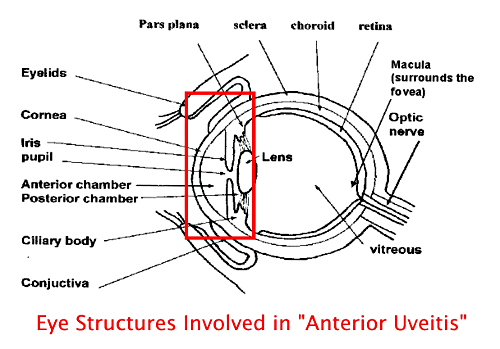What is Anterior Uveitis? (or iritis)
Anterior Uveitis is the most common form of uveitis, accounting for 75% of cases of Uveitis. It will often be referred to as Iritis as the iris is the part of the uvea that is usually inflamed. (the ciliary body may also be involved and this would be termed iridocyclitis). When looking for information on this subject it easy to get the impression that iritis is a different condition to uveitis. This is not the case.The iris is the coloured part of the eye which has a hole (the pupil) in the middle of it. The iris is a muscle which dilates the pupil, letting more light into the eye, or constricts it cutting down the amount of light that enters the eye. Behind this is another circular structure, the ciliary body. This produces the clear fluid which fills the eye, passing through the pupil and draining away near the edge of the iris. It also changes the eye's focus via muscles attached to the lens. Anterior Uveitis occurs when the iris and/or the ciliary body become inflamed.

Symptoms
- Redness of the eye
- Pain
- Photophobia (a need to avoid bright light) - the iris muscles shrink the pupil size in bright light and this movement in the inflamed iris causes pain.
- Blurring of vision (if the inflammation is severe).
Fortunately, for most people, Anterior Uveitis is the most readily treated of the uveitic conditions. It usually responds to treatment quickly but it often recurs regularly. It will usually not lead to any significant vision loss. However the condition must be carefully monitored because some people may:
- Suffer from complications
- Have other medical conditions known to be well associated with Anterior Uveitis.
Complications
1. Raised Eye Pressure and Synechiae
This occurs when the pressure of the fluid inside the eye is increased. This can threaten the eyesight and may cause glaucoma, but it can be monitored with a simple test and be treated with tablets or drops. In Ant. Uveitis the pressure can be raised due to the inflamed iris "sticking" to the lens (adhesions or synechiae) preventing the fluid from passing through the pupil. It can also be due to the inflammation of the area where the fluid drains out of the area where the fluid drains out of the eye. The other possible cause of a raised pressure is as a side-effect of the steroids used in the treatment.2. Cataracts
These are more likely to occur due to the Uveitis and also long term use of steroids.3. Macular Oedema
The Macula is the tiny part of the retina that is responsible for our central, or detailed part of our vision. Fluid (oedema) in this area may cause problems with central vision. This can mean difficulty making out people's faces, reading, driving and finding that straight lines appear distorted.It is wise to be aware of these complications but they are not usually present in most cases. see also Complicatioins of uveitis.
Causes
After a thorough medical history, eye and general examination is complete, no cause is found or known for approx 50% of Anterior Uveitis cases. This is called Idiopathic Anterior Uveitis. This does not mean to say that the doctors don't know anything about these particular cases. They are examples of autoimmune disease.Other forms of Ant. Uveitis are then grouped according to the different medical conditions that are found to exist. Associated medical conditions include Ankylosing spondylitis, Juvenile rheumatoid arthritis or (Juvenile chronic arthritis) and Inflammatory bowel disease. There are several more and more information about any specific condition can be provided on request.
Treatment
1. To relieve pain and photophobia
Mydriatic eye drops, such as atropine or cyclopentolate are used. These may be short or long acting and may be used for variable lengths of time depending on individual cases. The way a mydriatic works is that it "paralyses" the muscles of the iris and ciliary body. (It is the movement of these inflamed muscles that causes the pain.) When these drops have taken their effect the pupils will be dilated and vision may be blurred for a while.These mydriatics are also useful because they help prevent the complication mentioned earlier where the iris "sticks" to the lens.
2. To treat the inflammation
Steroids are used in the form of eye drops. Occasionally, but not often, injections of steroids are used around the eye. These may be uncomfortable but are straightforward and are done at the Eye Outpatient Clinics.Even more rarely steroid tablets are used.
The type of steroid treatment and the length it is used will, again vary a lot for different people. Side effects of steroid drops can include raised eye pressure which may cause glaucoma and cataracts. However the threat to vision in the long term is worse if adequate treatment is not given, and so the balance usually lies on the side of using whatever steroid treatment is necessary to completely stop the inflammation.

